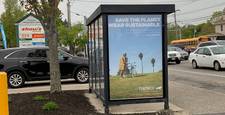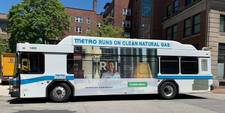Running a transit advertising operation is hard work, and that can leave smaller transit organizations that want to monetize their inventory struggling to optimize their business. The solution? Bring a larger entity in, one that sells and manages ad inventory for a number of similar transit companies, and reap the rewards of well-monetized inventory quicker, without compromising other operational duties.
In northeastern United States (New England), the region’s leading transit advertising company, ATA Outdoor, is providing these benefits to local transit authorities, with an eye on future expansion that will see its influence grow and diversify.
One-stop shop in the Northeast
Founded in 1992, ATA quickly began to make a name for itself by dramatically increasing ad revenue for its first transit partners. Contracts were secured in New Hampshire and Maine , the company steadily increasing its footprint across the northeastern US into Massachusetts and Vermont. Each added anywhere from 10 to 50 buses to ATA’s network.
Today, the company manages advertising for approximately 600 buses, along with about 20 billboards and other out-of-home products. Customers can enjoy full management of everything from creative services and printing to installation and graphics removal by the team at ATA. The result is an extremely efficient and painless process for buyers looking to get OOH campaigns out the door and on the road.
Better together
ATA counts 18+ different transit networks as partners, spanning a range of cities in Maine, New Hampshire, Vermont, and Massachusetts. While federal and state funding and grants provide much of the resources necessary for operating these networks, all rely heavily on advertising revenue to keep their transit systems running.
Some markets had previously operated their own ad sales, though found selling and managing media,on top of the existing work of running a transit network, prohibitively time-consuming. In forming a partnership with ATA, these companies found they could enjoy all the benefits of well-managed and monetized out-of-home without the additional demands on their time. They also experienced other benefits, such as increased visibility and greater appeal to clients who might want to advertise across multiple regional transit networks.
Now, media buyers looking to secure transit advertising in northern New England will likely partner with ATA. It’s a strong position to be in, and one that few other companies around the US have been able to establish.
The power of transit
Vermont and Maine are both no-billboard states, which leads some buyers to dismiss them entirely when planning out-of-home buys. This is a mistake. Streets and roadsides uncluttered by billboards make transit inventory managed by companies like ATA even more effective at drawing the eye.
For example, Northeast Delta Dental chose to buy space with ATA in Vermont, Maine, and New Hampshire for a large campaign aimed at driving awareness of their insurance offerings. The campaign helped Northeast Delta Dental to reach many businesses and individuals who might want to sign on, no billboards required.
And, of course, in states where ATA’s transit media coexist with billboards, the two combine to make a powerful impact above and along a region’s streets, further enhancing brand awareness.
Looking ahead, ATA is eyeing digital opportunities as the next avenue for expansion, with bus shelters and billboards the first candidates for conversion. And, even as new networks come on board and ATA’s business expands, the company intends to preserve its core goal of making transit advertising easier and more efficient for buyers and transit companies alike.
ATA and Ayuda
For many years, ATA’s operations were run through a maze of Excel spreadsheets that required a great deal of time and attention to manage. As ATA scaled up its operations, the complexities of selling transit media made it impossible to work with the efficiency the company demanded of itself. They worked for several years with a remote access inventory management software company, but it didn’t quite check all the required boxes.
In order to make operations both inside the office and out in the field more efficient, ATA Outdoor turned to the Ayuda platform. With the Juice sales tool, ATA can check available inventory, build proposals, and generate reports with just a few clicks. The Splash inventory management platform, meanwhile, allows them to view and manage all contracts, inventory, and rate cards from within a single program. They also intend to soon use the Ayuda Ops Tool to connect the sales and production department with the teams out in the field. This will ensure the right media gets posted to the right place at the right time.
With this combination, ATA Outdoor is poised to improve its operational efficiency in selling and deploying media across its hundreds of faces. It’s a winning recipe for preserving the standard of service that has helped ATA expand over the years, and will hopefully provide the streamlining necessary for continued growth.
Looking to optimize ad sales for transit OOH media?
Learn how the Ayuda platform can help!









